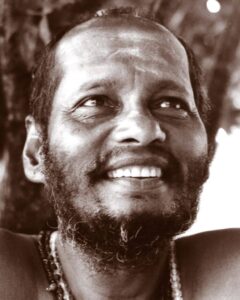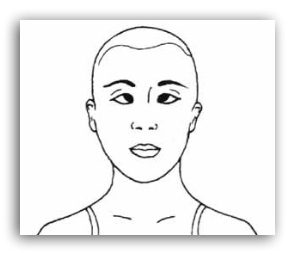Shambhavi Mudra or Shambhavi Kriya or Shambhavi Mahamudra is also known as bhrumadhya drishti, i.e., gazing at the eyebrow centre. The word Shambhavi here denotes the creative potential of consciousness. In yogic literature, Shiva is called Shambu, and Shambhavi is used to stir or awaken that Shambu.
Shiva or Shambu is synonymous with supra-consciousness, heightened awareness, or cosmic awareness in Yoga.
Before we learn Shambhavi Mudra Online we must understand the experiences seasoned practitioners of Yoga have had with this kriya.
Shambhavi Mudra Experience
In Hatha Yoga Pradipika, Chapter 3 is dedicated to all the important mudras, but Shambhavi Is not included there. Instead, it is included in chapter 4 called Samadhi. This is because it is believed – on account of experiences reported by seasoned practitioners of meditations – that Shambhavi happens automatically during Samadhi.

Swami Muktanada Paramahamsa (founder of Siddha Yoga) also attested to this when he described how automatically his eyebrows took the position of this mudra when he was in deep states of consciousness [1].
Theos Bernard (a prominent yoga practitioner) in his seminal book on Hatha Yoga, writes about his shambhavi mudra experience–
By using this technique, I was eventually able to see this white light with my eyes wide open in the daylight. The mind seemed to be wiped out completely and nothing existed but this brilliant light. After a time, it became no problem to make it appear at will, whether sitting or walking about. I frequently did so when on my morning stroll [2].
– Theos Bernard, Practitioner & Scholar
What is Shambhavi Mudra?
In Sanskrit, the ancient yogic scriptures write:

Translation
“With internalized (one-pointed) awareness and external gaze unblinking, that verily is shambhavi mudra, preserved in the Vedas.”
Also:

Translation
“If the yogi remains with the chitta and prana absorbed in the internal object and gaze motionless, though looking, he is not seeing, it is indeed shambhavi mudra. When it is given by the guru’s blessing, the state of shoonyashoonya arises. That is the real state of Shiva (consciousness).”
Shambhavi Mudra Steps

- Sit in a meditative posture, with your back straight. It is vital that you sit in a pose where your spine is straight and not drooping or reclining. The wrong posture might cause an imbalance in energies and lead to unwarranted side effects from the practice. The preferred posture is siddhasana or siddha yoni asana. The hands should be placed on the knees either in jnana or chin mudra.
- Open your eyes and gaze upwards at the centre of your eyebrows. Keep the eyes steady and hold them in that position as long as possible.
- When the eyes get tired then close them. With eyes closed keep your gaze fixed on the chidakasha, i.e., the space in front of your closed eyes.
- As you keep practising (within a few weeks) an impression of light will start forming when your eyes are open and gazing upwards. Eventually, this light will also appear when your eyes are closed.
- Once you start seeing that light, concentrate on it and it must be held in the centre of your eyebrows.
Note
- Shambhavi Mahamudra can be practised either in isolation or in combination with other yoga practices like pranayama and asanas.
- Advanced students can practice it with closed eyes. Generally, once you can practice it easily with open eyes without getting tired, you can start practising it with closed eyes.
- Start with 5 minutes and gradually increase it to 15 minutes.
- For a longer duration, say you want to do Shambhavi Mahamudra Kriya for 21 minutes or more, an expert’s guidance is required.
Shambhavi Mudra Secrets
Hatha Yoga Pradipika writes about the secret powers associated with Shambhavi in the following verse:

Translation
“The two states, the Sambhavi and the Khechari are different because of their seats (being the heart and the space between the eyebrows respectively); but both cause happiness, for the mind becomes absorbed in the Chita-sukha-Rupa-atmana which is void.”
Thus, we see this mudra causes the mind easily achieve the no-mind state. This is a state where the mind is calm, balanced and ready for dhyana.
Shambhavi Mudra Benefits
- Shambhavi kriya directly awakens the Ajna chakra.
- Both shambhavi and khechari make the external mind turn off and cause inner calmness and awareness.
- Shambhavi mudra leads to unmani (“no mind,” “beyond the mind” or “thoughtless”) [3].
- It is said that perfect concentration is meditation and perfect meditation is samadhi.
- When you gaze upon the white light appearing between your eyebrows, eventually your awareness of everything else will cease to exist except the light. This is a state of unmani through shambhavi mudra.
Shambhavi Mudra Precautions
- Theos Bernard goes on to warn that this practice is to be learned from an experienced teacher or guru. He also says that this practice requires sincerity and perseverance before higher experiences can be awakened.
- Chapter 4, Verse 35 of Hatha Yoga Pradipika – in considering one of its interpretations – also hints that only the initiated were taught this practice.
- Don’t focus too hard or strain yourself while concentrating. Always remain calm and relaxed and listen to your body. If you are facing headaches or body pains after the practice that is severe, stop the practice immediately and seek an expert’s guidance.
- Always start any yoga practice for the least interval of time and gradually increase.
- Posture should be such that the back/spine is always straight. No compromise can be made with this basic rule.
References
- Book: Hatha Yoga Pradipika: Light On Hatha Yoga, commentary by Swami Mukti Bodhananda [link]
- Book: Hatha Yoga – The report of a personal experience, by Theos Bernard
- Book: Hatha Yoga Pradipika by Swami Swatmarama (Original Author), translation by published The Big Nest
- Book: Hatha Yoga Pradipika: A Manual of Kriya Yoga by Shailendra Sharma

1 thought on “Shambhavi Mahamudra Kriya – Steps, Benefits, Secrets & Precautions”